
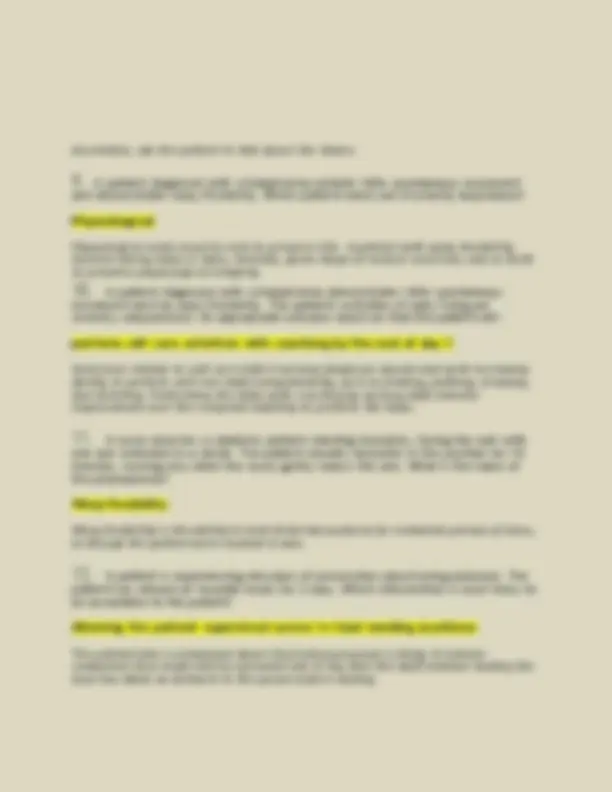
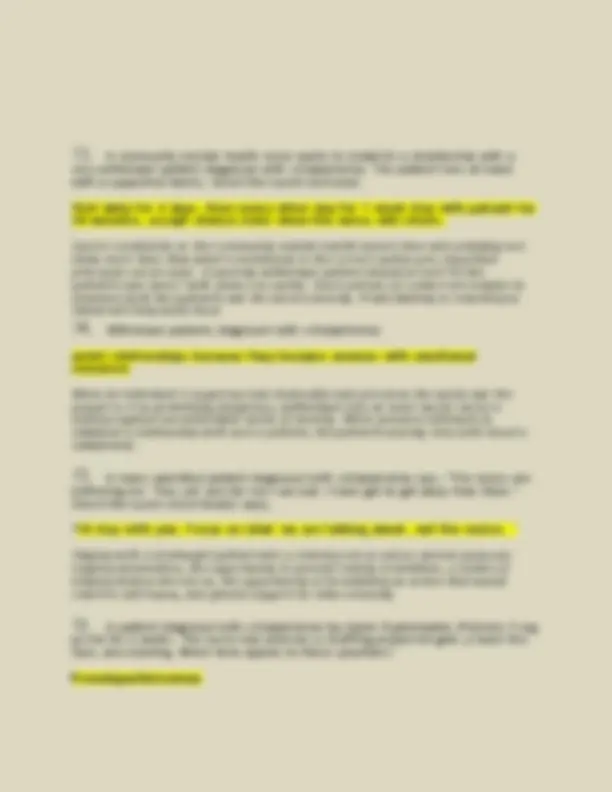
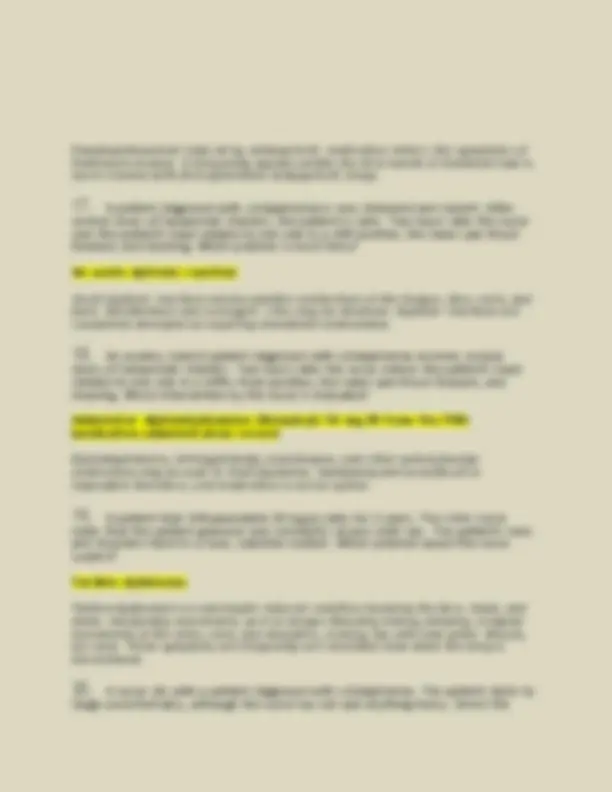
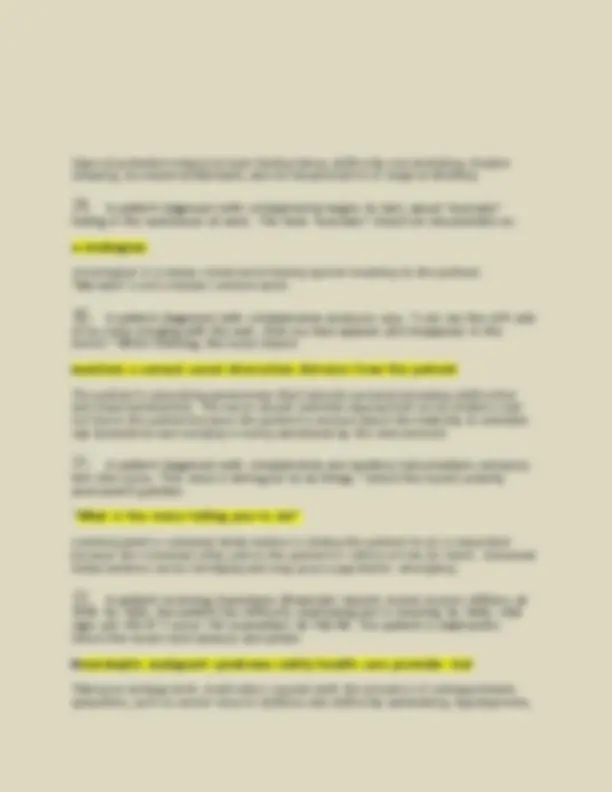
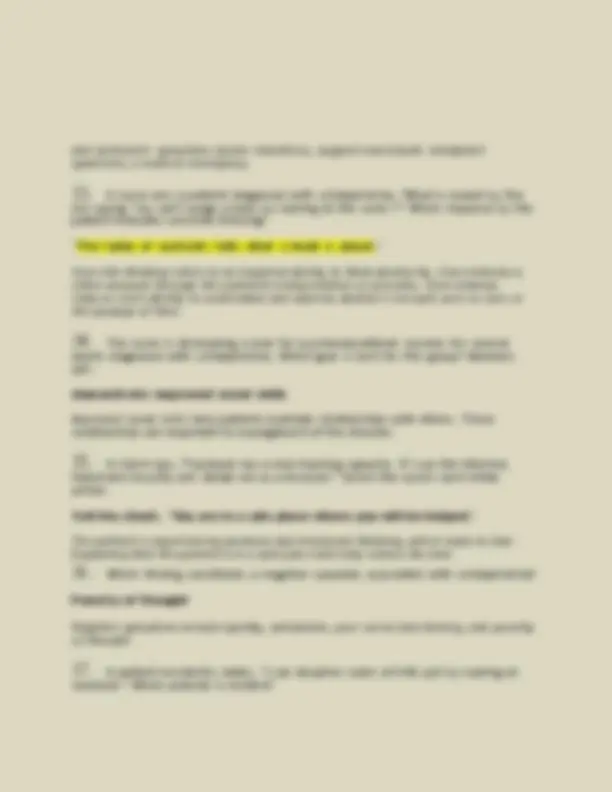
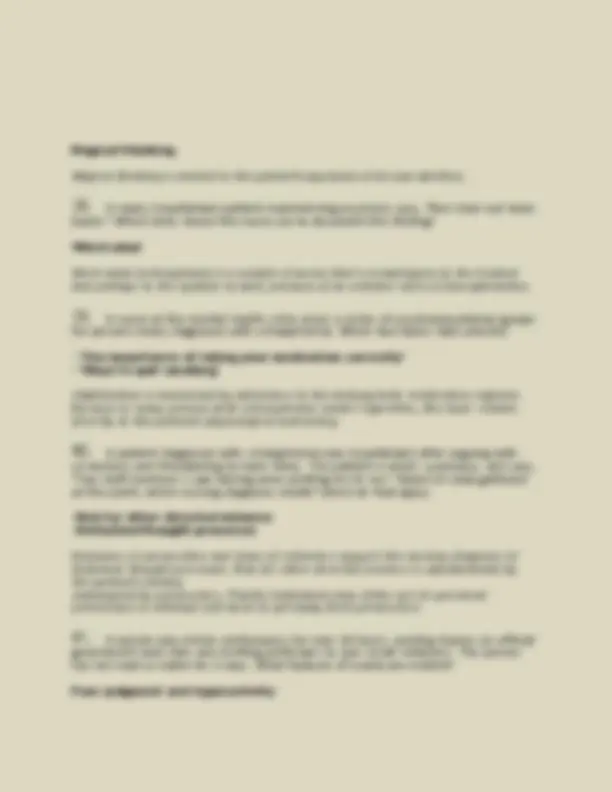
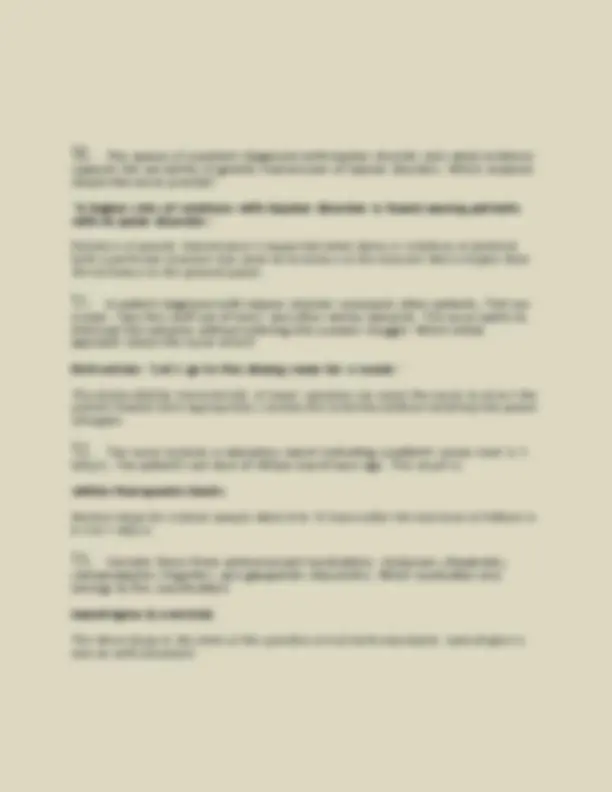
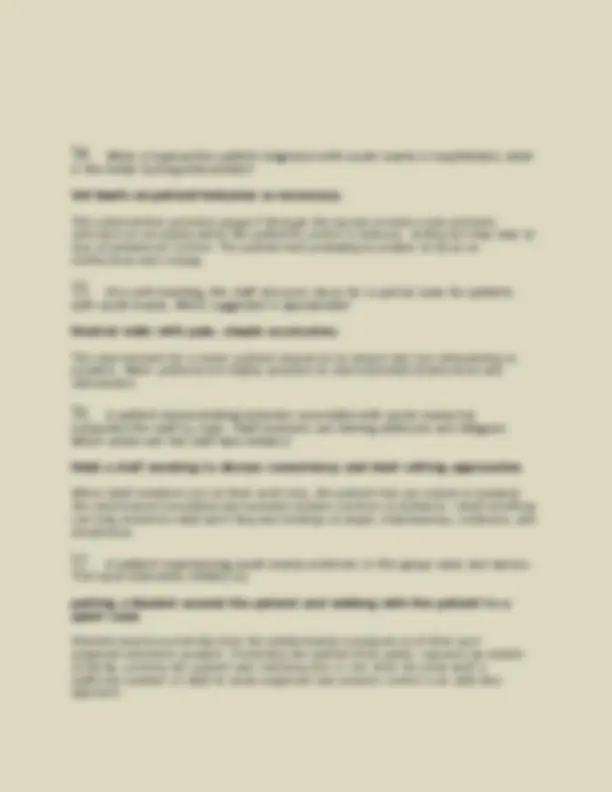
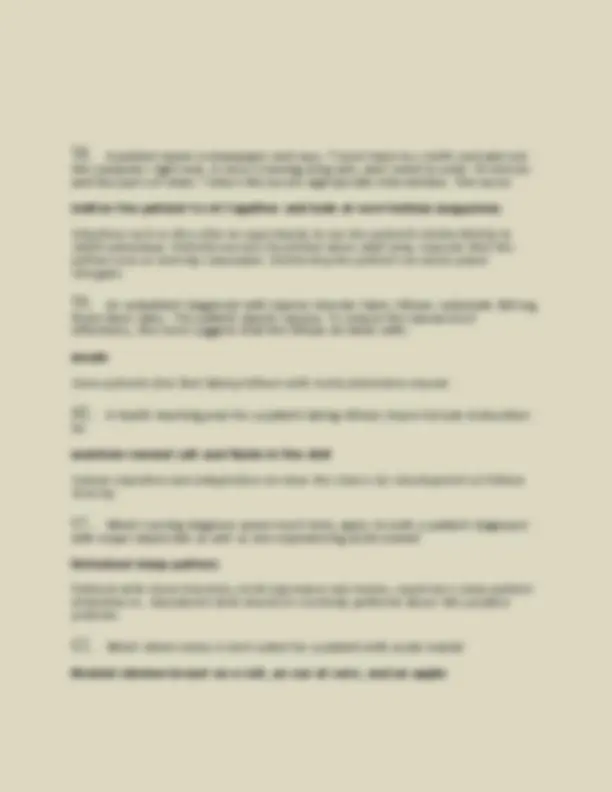
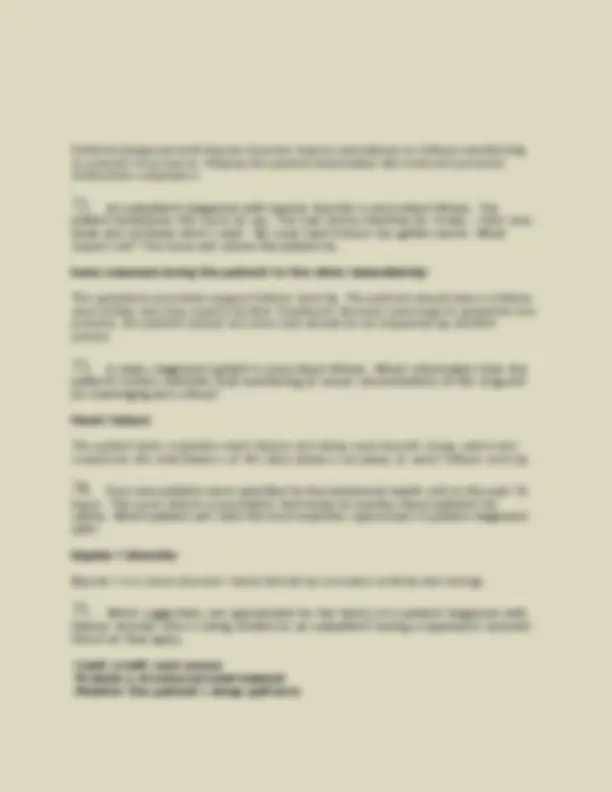
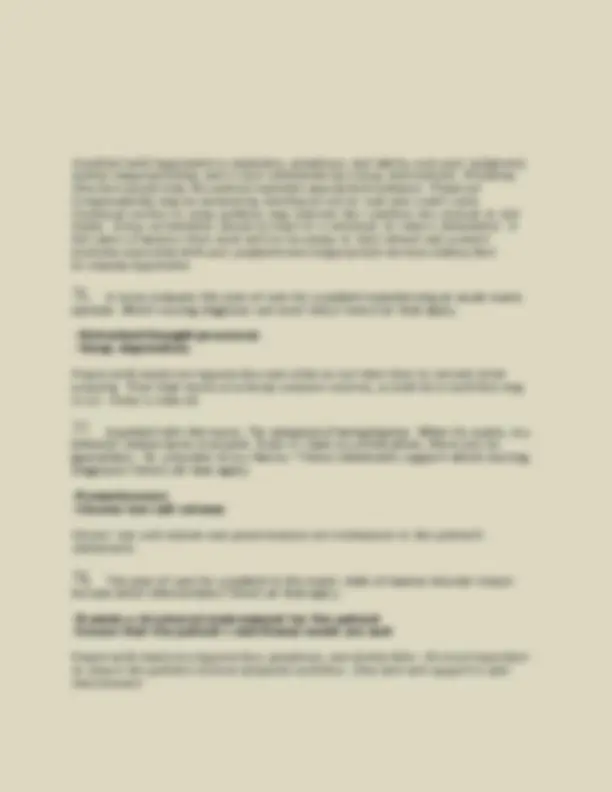
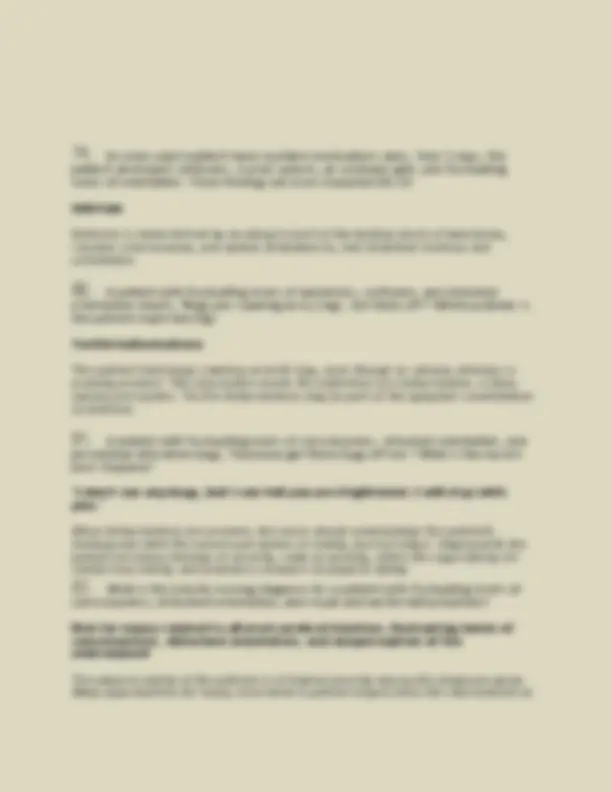
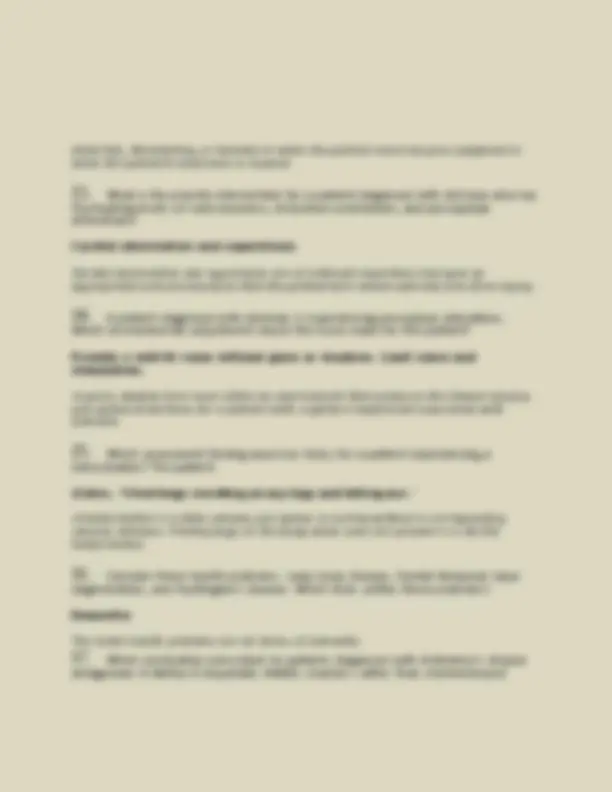
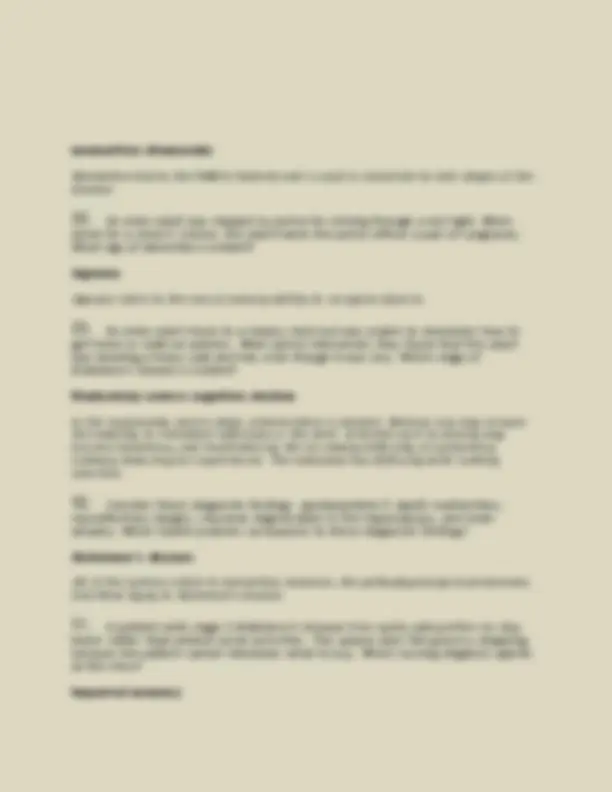
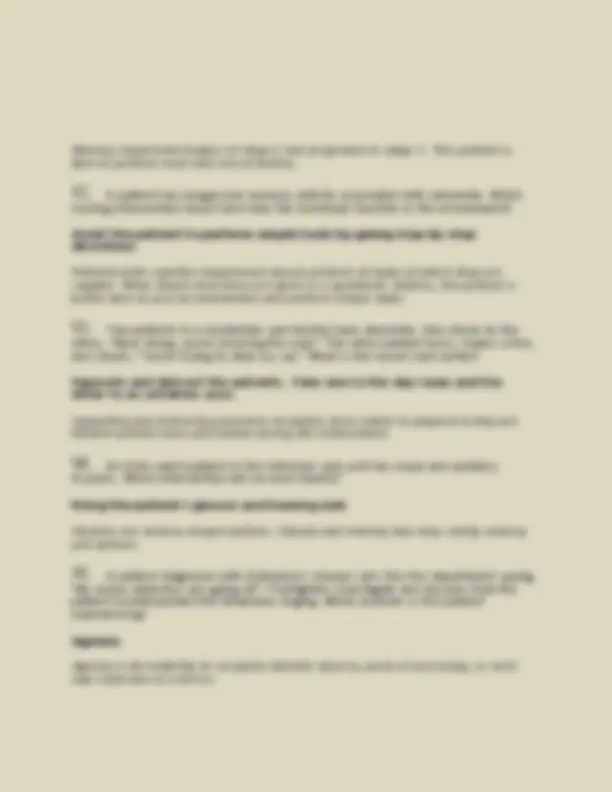
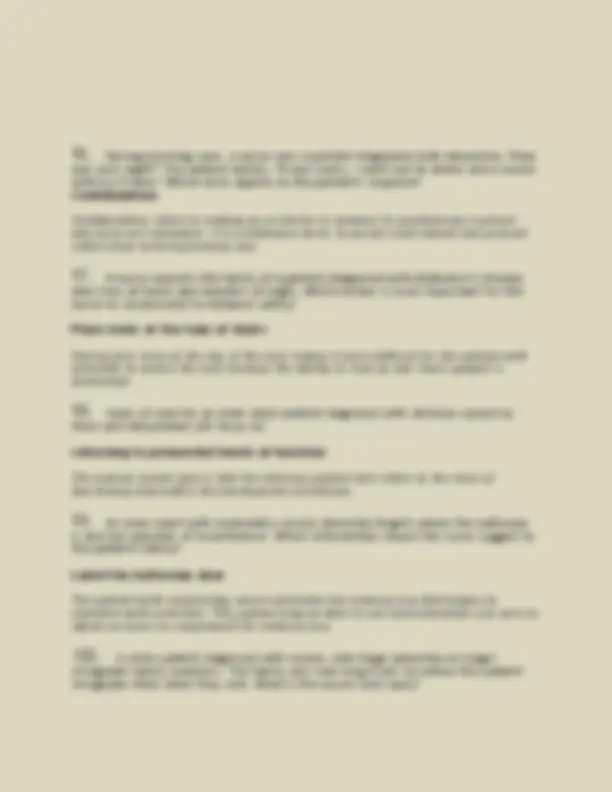
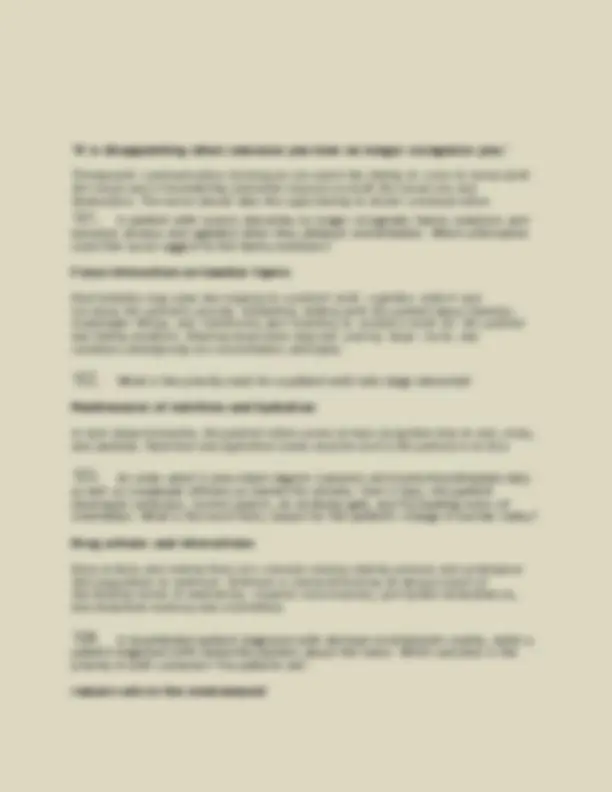
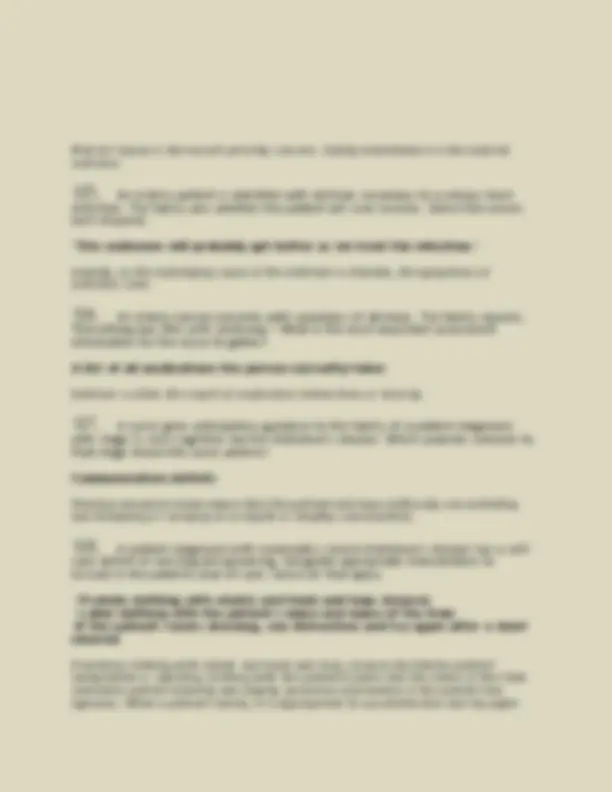
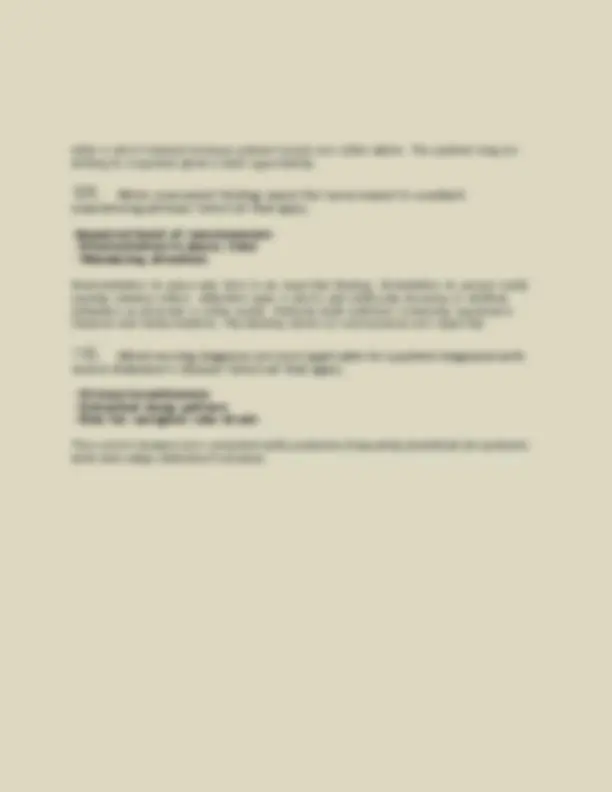


Study with the several resources on Docsity

Earn points by helping other students or get them with a premium plan


Prepare for your exams
Study with the several resources on Docsity

Earn points to download
Earn points by helping other students or get them with a premium plan
Community
Ask the community for help and clear up your study doubts
Discover the best universities in your country according to Docsity users
Free resources
Download our free guides on studying techniques, anxiety management strategies, and thesis advice from Docsity tutors
Insights into the nursing care and management of patients diagnosed with schizophrenia and bipolar disorder. It covers various aspects, including medication management, symptom assessment, patient safety, and nursing interventions. The document highlights the importance of understanding the unique challenges faced by these patients, such as auditory hallucinations, delusions, mood instability, and risk of harm. It also emphasizes the role of the nurse in providing reality orientation, reducing anxiety, and promoting self-care and social skills. Additionally, the document touches on the genetic factors and environmental influences associated with these mental health conditions. Overall, this document offers a comprehensive overview of the nursing considerations and best practices in caring for individuals with schizophrenia and bipolar disorder.
Typology: Exams
1 / 27

This page cannot be seen from the preview
Don't miss anything!




















and accusing them of conspiracy. Today the person shouts, "They're all plotting to destroy me. Isn't that true?" Select the nurse's most therapeutic response. "Feeling that people want to destroy you must be very frightening." Resist focusing on content instead, focus on the feelings the patient is expressing. This strategy prevents arguing about the reality of delusional beliefs. Such arguments increase patient anxiety and the tenacity with which the patient holds to the delusion.
constantly scans the environment. The patient states, "I saw two doctors talking in the hall. They were plotting to kill me." The nurse may correctly assess this behavior as: an idea of reference Ideas of reference are misinterpretations of the verbalizations or actions of others that give special personal meanings to these behaviors for example, when seeing two people talking, the individual assumes they are talking about him or her.
I also saw two doctors plotting to kill me." How does this patient perceive the environment? Dangerous The patient sees the world as hostile and dangerous. This assessment is important because the nurse can be more effective by using empathy to respond to the patient.
haloperidol (Haldol) was prescribed. The patient now says, "I stopped taking those pills. They made me feel like a robot." What are common side effects the nurse should validate with the patient? Sedation and muscle stiffness Typical antipsychotic drugs often produce sedation and extrapyramidal side effects such as stiffness and gait disturbance, effects the patient might describe as making
him or her feel like a "robot."
patient says, "The voices say everyone is trying to kill me." The correct response indicates the patient is experiencing paranoia. Paranoia often leads to fearfulness, and the patient may attempt to strike out at others to protect self.
assessment findings suggest the patient may be hallucinating? Darting eyes, tilted head, mumbling to self Clues to hallucinations include eyes looking around the room as though to find the speaker, tilting the head to one side as though listening intently, and grimacing, mumbling, or talking aloud as though responding conversationally to someone.
a patient diagnosed with schizophrenia who has auditory hallucinations and poor social function. The patient is also overweight and hypertensive. Which drug should the nurse advocate? aripiprazole (Abilify) Aripiprazole is a third-generation atypical antipsychotic effective against both positive and negative symptoms of schizophrenia. It causes little or no weight gain and no increase in glucose, high- or low-density lipoprotein cholesterol, or triglycerides, making it a reasonable choice for a patient with obesity or heart disease.
end. Easter. It blows away. Get it?" Select the nurse's best response. "I am having difficulty understanding what you are saying." When a patient's speech is loosely associated, confused, and disorganized, pretending to understand is useless. The nurse should tell the patient that he or she is having difficulty understanding what the patient is saying. If a theme is
very withdrawn patient diagnosed with schizophrenia. The patient lives at home with a supportive family. Select the nurse's best plan. Visit daily for 4 days, then every other day for 1 week stay with patient for 20 minutes, accept silence state when the nurse will return. Severe constraints on the community mental health nurse's time will probably not allow more time than what is mentioned in the correct option yet, important principles can be used. A severely withdrawn patient should be met "at the patient's own level," with silence accepted. Short periods of contact are helpful to minimize both the patient's and the nurse's anxiety. Predictability in returning as stated will help build trust.
avoid relationships because they become anxious with emotional closeness When an individual is suspicious and distrustful and perceives the world and the people in it as potentially dangerous, withdrawal into an inner world can be a defense against uncomfortable levels of anxiety. When someone attempts to establish a relationship with such a patient, the patient's anxiety rises until trust is established.
bothering me. They yell and tell me I am bad. I have got to get away from them." Select the nurse's most helpful reply. "I'll stay with you. Focus on what we are talking about, not the voices. " Staying with a distraught patient who is hearing voices serves several purposes: ongoing observation, the opportunity to provide reality orientation, a means of helping dismiss the voices, the opportunity of forestalling an action that would result in self-injury, and general support to reduce anxiety.
po bid for 3 weeks. The nurse now observes a shuffling propulsive gait, a mask-like face, and drooling. Which term applies to these symptoms? Pseudoparkinsonism
Pseudoparkinsonism induced by antipsychotic medication mimics the symptoms of Parkinson's disease. It frequently appears within the first month of treatment and is more common with first-generation antipsychotic drugs.
several doses of haloperidol (Haldol), the patient is calm. Two hours later the nurse sees the patient's head rotated to one side in a stiff position, the lower jaw thrust forward, and drooling. Which problem is most likely? An acute dystonic reaction Acute dystonic reactions involve painful contractions of the tongue, face, neck, and back. Opisthotonos and oculogyric crisis may be observed. Dystonic reactions are considered emergencies requiring immediate intervention.
doses of haloperidol (Haldol). Two hours later the nurse notices the patient's head rotated to one side in a stiffly fixed position, the lower jaw thrust forward, and drooling. Which intervention by the nurse is indicated? Administer diphenhydramine (Benadryl) 50 mg IM from the PRN medication administration record Diphenhydramine, trihexyphenidyl, benztropine, and other anticholinergic medications may be used to treat dystonias. Swallowing will be difficult or impossible therefore, oral medication is not an option.
notes that the patient grimaces and constantly smacks both lips. The patient's neck and shoulders twist in a slow, snakelike motion. Which problem would the nurse suspect? Tardive dyskinesia Tardive dyskinesia is a neuroleptic-induced condition involving the face, trunk, and limbs. Involuntary movements, such as tongue thrusting licking, blowing, irregular movements of the arms, neck, and shoulders, rocking, hip jerks and pelvic thrusts, are seen. These symptoms are frequently not reversible even when the drug is discontinued.
laugh uncontrollably, although the nurse has not said anything funny. Select the
Lurasidone HCL (Latuda) is a second-generation antipsychotic medication. The incidence of weight gain, diabetes, and high cholesterol is high with this medication. The patient is overweight now, so weight management will be especially important.
for the cat." What type of verbalization is evident? Associative looseness Looseness of association refers to jumbled thoughts incoherently expressed to the listener.
antipsychotic medication for a year. Hallucinations are less intrusive, but the patient continues to have apathy, poverty of thought, and social isolation. The nurse would expect a change to which medication? Olanzapine (Zyprexa) Olanzapine is a second-generation atypical antipsychotic that targets both positive and negative symptoms of schizophrenia.
illness and family's role in recovery. Which type of therapy should the nurse recommend? Psychoeducational A psychoeducational group explores the causes of schizophrenia, the role of medication, the importance of medication compliance, support for the ill member, and hints for living with a person with schizophrenia. Such a group can be of immeasurable practical assistance to the family.
the family now reports the patient is tense, sleeps 3 to 4 hours per night, and has difficulty concentrating. The patient says, "My computer is sending out infected radiation beams." The nurse can correctly assess this information as an indication of: relapse
Signs of potential relapse include feeling tense, difficulty concentrating, trouble sleeping, increased withdrawal, and increased bizarre or magical thinking.
hiding in the warehouse at work. The term "macnabs" should be documented as: a neologism A neologism is a newly coined word having special meaning to the patient. "Macnabs" is not a known common word.
of my body merging with the wall, then my face appears and disappears in the mirror." While listening, the nurse should: maintain a normal social interaction distance from the patient The patient is describing phenomena that indicate personal boundary difficulties and depersonalization. The nurse should maintain appropriate social distance and not touch the patient because the patient is anxious about the inability to maintain ego boundaries and merging or being swallowed by the environment.
tells the nurse, "The voice is telling me to do things." Select the nurse's priority assessment question. "What is the voice telling you to do?" Learning what a command hallucination is telling the patient to do is important because the command often places the patient or others at risk for harm. Command hallucinations can be terrifying and may pose a psychiatric emergency.
Magical thinking Magical thinking is evident in the patient's appraisal of his own abilities.
board." Which term should the nurse use to document this finding? Word salad Word salad (schizophasia) is a jumble of words that is meaningless to the listener and perhaps to the speaker as well, because of an extreme level of disorganization.
for persons newly diagnosed with schizophrenia. Which two topics take priority?
**- "The importance of taking your medication correctly"
co-workers and threatening to harm them. The patient is aloof, suspicious, and says, "Two staff members I saw talking were plotting to kill me." Based on data gathered at this point, which nursing diagnoses relate? Select all that apply.
**- Risk for other-directed violence
government web-sites and inviting politicians to join social networks. The person has not slept or eaten for 3 days. What features of mania are evident? Poor judgment and hyperactivity
Hyperactivity (activity without sleep) and poor judgment (posting rhymes on government web-sites) are characteristic of manic episodes.
bright scarves. The patient twirls and shadow boxes. The patient says gaily, "Do you like my scarves? Here; they are my gift to you." How should the nurse document the patient's mood? Euphoric The patient has demonstrated clang associations and pleasant, happy behavior. Excessive happiness indicates euphoria.
jerk, for perks" and making obscene gestures at cars. The person has not slept or eaten for 3 days. Which assessment findings will have priority concern for this patient's plan of care? Hyperactivity; not eating and sleeping Hyperactivity, poor nutrition, hydration, and not sleeping take priority in terms of the needs listed above because they threaten the physical integrity of the patient.
business venture on a street corner for 2 days. Which nursing diagnosis has priority? Risk for injury Although each of the nursing diagnoses listed is appropriate for a patient having a manic episode, the priority lies with the patient's physiological safety. Hyperactivity and poor judgment put the patient at risk for injury.
discontinuing lithium. The patient threatens to hit another patient. Which comment by the nurse is appropriate? "Do not hit anyone. If you are unable to control yourself, we will help you." When the patient is unable to control his or her behavior and violates or threatens to violate the rights of others, limits must be set in an effort to deescalate the situation. Limits should be set in simple, concrete terms.
supports the possibility of genetic transmission of bipolar disorders. Which response should the nurse provide? "A higher rate of relatives with bipolar disorder is found among patients with bi-polar disorder." Evidence of genetic transmission is supported when twins or relatives of patients with a particular disorder also show an incidence of the disorder that is higher than the incidence in the general public.
a book. Take this stuff out of here," and other similar demands. The nurse wants to interrupt this behavior without entering into a power struggle. Which initial approach should the nurse select? Distraction: "Let's go to the dining room for a snack." The distractibility characteristic of manic episodes can assist the nurse to direct the patient toward more appropriate, constructive activities without entering into power struggles.
mEq/L. The patient's last dose of lithium was 8 hours ago. This result is: within therapeutic limits Normal range for a blood sample taken 8 to 12 hours after the last dose of lithium is 0.4 to 1 mEq/L.
carbamazepine (Tegretol), and gabapentin (Neurontin). Which medication also belongs to this classification? lamotrigine (La-mictal) The three drugs in the stem of the question are all anticonvulsants. Lamotrigine is also an anticonvulsant.
is the initial nursing intervention? Set limits on patient behavior as necessary This intervention provides support through the nurse's presence and provides structure as necessary while the patient's control is tenuous. Acting out may lead to loss of behavioral control. The patient will probably be unable to focus on instructions and comply.
with acute mania. Which suggestion is appropriate? Neutral walls with pale, simple accessories The environment for a manic patient should be as simple and non-stimulating as possible. Manic patients are highly sensitive to environmental distractions and stimulation.
exhausted the staff by noon. Staff members are feeling defensive and fatigued. Which action will the staff take initially? Hold a staff meeting to discuss consistency and limit-setting approaches When staff members are at their wits' end, the patient has succeeded in keeping the environment unsettled and avoided outside controls on behavior. Staff meetings can help minimize staff split-ting and feelings of anger, helplessness, confusion, and frustration.
The nurse intervenes initially by: putting a blanket around the patient and walking with the patient to a quiet room Patients must be protected from the embarrassing consequences of their poor judgment whenever possible. Protecting the patient from public exposure by matter- of-factly covering the patient and removing him or her from the area with a sufficient number of staff to avoid argument and provide control is an effective approach.
These foods provide adequate nutrition, but more important they are finger foods that the hyperactive patient could "eat on the run."
grandiose thinking associated with acute mania will focus on: distorted thought self-control The desired outcome is that the patient will be able to control the grandiose thinking associated with acute mania as evidenced by making realistic comments about self, abilities, and plans. Patients with acute mania are already unduly optimistic as a result of their use of denial, and they are overly interested in their environment.
diagnosed with acute mania has been effective? "Converses with few interruptions; clothing matches; participates in activities." The descriptors given indicate the patient is functioning at an optimal level, using appropriate behavior, and thinking without becoming overstimulated by unit activities.
monopolizes conversations, interrupts, and intrudes. Which nursing intervention will best assist the patient with energy conservation? Provide a subdued environment Providing a subdued environment directly relates to the outcome of energy conservation by decreasing stimulation and helping to balance activity and rest.
been taking lithium 600 mg tid. Staff observes increased agitation, pressured speech, poor personal hygiene, and hyperactivity. Which action demonstrates that the nurse understands the most likely cause of the patient's behavior? Consider the need to check the lithium level. The patient may not be swallowing medications. The patient is continuing to exhibit manic symptoms. The lithium level may be low from "cheeking" (not swallowing) the medication.
The nurse should: arrange for one-on-one supervision A patient who repeatedly disrobes despite verbal limit setting needs more structure. One-on-one supervision may provide the necessary structure.
clear the room of all other patients Safety is of primary importance. Once other patients are out of the room, a plan for managing this patient can be implemented.
patient is taking a mood stabilizing medication. What is the priority nursing intervention for the patient as well as the patient's family during this phase of treatment? Attending psychoeducation sessions During the continuation phase of treatment for bipolar disorder, the physical needs of the patient are not as important an issue as they were during the acute episode. After hospital discharge, treatment focuses on maintaining medication compliance and preventing relapse, both of which are fostered by ongoing psychoeducation.
evidence of complications? Diaphoresis, weakness, and nausea Diaphoresis, weakness, and nausea are early signs of lithium toxicity.
treatment. The patient asks, "Do I have to keep taking this lithium even though my mood is stable now?" Select the nurse's appropriate response. "Taking the medication every day helps reduce the risk of a relapse."
A patient with hypomania is expansive, grandiose, and labile; uses poor judgment; spends inappropriately; and is over-stimulated by a busy environment. Providing structure would help the patient maintain appropriate behavior. Financial irresponsibility may be avoided by limiting access to cash and credit cards. Continued decline in sleep patterns may indicate the condition has evolved to full mania. Group socialization should be kept to a minimum to reduce stimulation. A full leave of absence from work will be necessary to limit stimuli and prevent problems associated with poor judgment and inappropriate decision making that accompany hypomania.
episode. Which nursing diagnoses are most likely? Select all that apply.
**- Disturbed thought processes
behavior embarrasses everyone. Even if I take my medication, there are no guarantees. I'm a burden to my family." These statements support which nursing diagnoses? Select all that apply.
**- Powerlessness
include which interventions? Select all that apply.
**- Provide a structured environment for the patient
patient developed confusion, slurred speech, an unsteady gait, and fluctuating levels of orientation. These findings are most characteristic of: delirium Delirium is characterized by an abrupt onset of fluctuating levels of awareness, clouded consciousness, perceptual disturbances, and disturbed memory and orientation.
orientation shouts, "Bugs are crawling on my legs. Get them off!" Which problem is the patient experiencing? Tactile hallucinations The patient feels bugs crawling on both legs, even though no sensory stimulus is actually present. This description meets the definition of a hallucination, a false sensory perception. Tactile hallucinations may be part of the symptom constellation of delirium.
perceptual alteration begs, "Someone get these bugs off me." What is the nurse's best response? "I don't see any bugs, but I can tell you are frightened. I will stay with you." When hallucinations are present, the nurse should acknowledge the patient's feelings and state the nurse's perception of reality, but not argue. Staying with the patient increases feelings of security, reduces anxiety, offers the opportunity for reinforcing reality, and provides a measure of physical safety.
consciousness, disturbed orientation, and visual and tactile hallucinations? Risk for injury related to altered cerebral function, fluctuating levels of consciousness, disturbed orientation, and misperception of the environment The physical safety of the patient is of highest priority among the diagnoses given. Many opportunities for injury exist when a patient misperceives the environment as